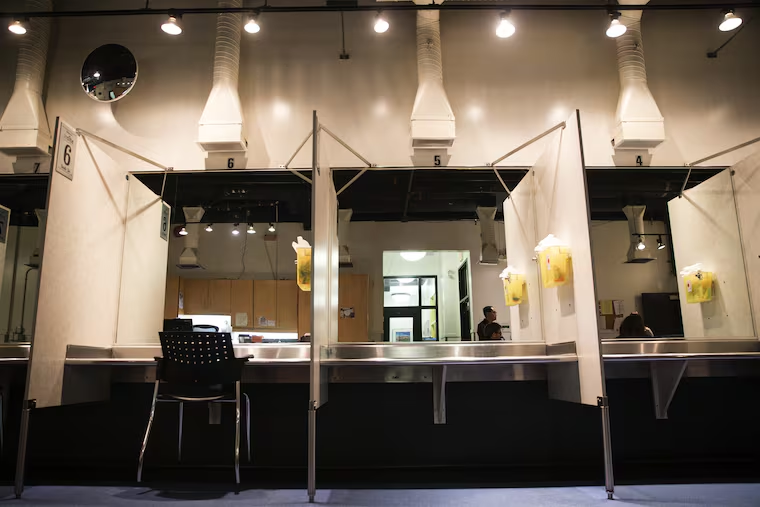Where Philadelphia stands on supervised-injection sites, per two polls | Opinion
The responses to supervised-injection sites in the Inquirer's and Pew's issue polls might seem contradictory. They in fact together tell a full story.

In the year and three months since the city gave the green light to a public entity to open a supervised injection site, there has been vigorous public debate over the issue, including heated town-hall meetings. However, there was no public polling on where the city as a whole stands on the issue. Now, less than three weeks ahead of the May 21 primary election, there are two.
On Monday, The Inquirer published a SurveyUSA poll of 865 registered voters about the state of the city, the mayor’s performance, and specific issues. A few days after, Pew Charitable Trusts published a poll of 600 Philadelphia residents about the trajectory of the city as well as specific issues.
The polls are generally consistent. In both polls, the top issue for respondents was crime (37 percent of Inquirer respondents chose “crime” as their top issue and 41 percent of Pew respondents chose “crime/drugs/safety” as theirs). A majority of respondents don’t like the soda tax (62 percent of Inquirer respondents called it a “complete failure” or “failure,” and 66 percent of Pew respondent “disapprove” of it), and a majority of respondents don’t like the tax abatement as it stands (57 percent of Inquirer respondents said the abatement is “bad for the city” and 57 percent of Pew respondents said it should be “eliminated” or “reduced”).
Yet the polls diverge dramatically on supervised injection sites. The Inquirer poll shows a city that strongly opposes the harm-reduction measure, and the Pew poll shows a city that is divided on the issue with 50 percent of residents supportive.
But the results of the two polls are not in fact mutually exclusive — they just ask different questions, and together enrich our picture of how Philadelphians feel about the city’s response to the overdose crisis.
The Inquirer poll asked: ”Should the city of Philadelphia designate an area where those who wish to inject themselves with illegal drugs are allowed to do so, free from the risk of arrest?” 67 percent said no, 22 said yes.
The question, as phrased, is not a rebuke of sup injection sites, but of a designated area where people can inject illegal drugs free from arrest. That area exists — ask the people of Kensington. What were the encampments under the bridges if not exactly that kind of place? It actually encapsulates the frustration of folks in neighborhoods like Kensington, where public injection, dropped needles and syringes, and drug dealers — often armed — are a part of an unacceptable new normal. The cry that is coming out of Kensington, and which often falls on deaf ears among both advocates and city officials, can be summarized as: Why did our neighborhood become the designated area for the crisis in the city?
On the other hand, the Pew poll asked: “Philadelphia is considering creating a safe site where opioid users could take their drugs under medical supervision. Is this something you favor or oppose?” 50 percent said they are in favor, 44 percent opposed.
Considering the stigma around injection drug use, decades of “Just Say No” antidrug campaigns, and that up until about a year ago, most people in Philadelphia never heard about supervised injection sites — and the abundance of misinformation spread about the sites since — having 1-in-2 residents of Philadelphia support opening a supervised injection site should exceed the expectations of any advocate.
The divide Pew found on supervised injection is reflected in the large field of candidates for City Council’s at-large seats. Of the 24 Democrats who responded to the Inquirer Editorial Board’s candidate questionnaire, 15 candidates — 63 percent — support opening a site. All seven Republicans oppose.
Taking the Inquirer and Pew results together, we start to get a cohesive picture: that a majority of Philadelphians are unhappy with the status quo, and that half of Philadelphians think a supervised injection site is an appropriate step forward. Around the world, supervised injection sites respond exactly to the concerns of residents in areas impacted hard by the crisis, and the evidence shows they are working — reducing the rate of public injection and dropped syringes, for example. They are a logical step in a comprehensive strategy to both save lives and improve neighborhood conditions.
Just like the two different questions, there are two conversations going on right now in Philadelphia about supervised-injection sites. One is a macro conversation about whether these sites are a legitimate and efficacious tool that should be considered as part of our response to the overdose crisis. The evidence to support a site in Philadelphia is overwhelming. The much harder conversation is the micro one about where and how it would work: Where should a site be? How many sites? What should be the model of operation? And who should take responsibility for the site? Philadelphia is far from pinpointing those critical details, and that is a conversation we must engage in together.
That’s the takeaway from these latest polls: Philadelphians are frustrated that the city allowed for whole neighborhoods to become unsafe and unsupervised injection sites, and many are ready to have a site up and running instead. We just have to make sure that we get it right.